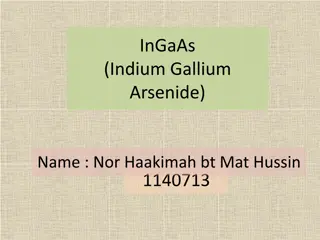
Indium Antimonide: Properties, Applications, and Nanostructures
Discover the properties, applications, and nanostructures of Indium Antimonide (InSb), a crystalline compound used in infrared detectors, thermal imaging cameras, and more. Explore its synthesis methods, structural stability, and electronic properties, including p- and n-doped variations for enhanced device performance.
Download Presentation

Please find below an Image/Link to download the presentation.
The content on the website is provided AS IS for your information and personal use only. It may not be sold, licensed, or shared on other websites without obtaining consent from the author. If you encounter any issues during the download, it is possible that the publisher has removed the file from their server.
You are allowed to download the files provided on this website for personal or commercial use, subject to the condition that they are used lawfully. All files are the property of their respective owners.
The content on the website is provided AS IS for your information and personal use only. It may not be sold, licensed, or shared on other websites without obtaining consent from the author.
E N D
Presentation Transcript
INDIUM ANTIMONIDE
Indium Antimonide Crystalline compound made form element indium and antimony Chemical formula : InSb Small band gap Application : infrared detector, thermal imaging camera, infrared spectroscopy
Summary of comparisons Mostly, Indium Antimonide were involve in thermal conductivity The method that was be used is : -Vapor Liquid Solid Mechanism -Chemical Vapor Deposition -Evaporation of Indium Antimonide -Density functional theory (DFT) Objective of experiment: -Synthesis and properties of InSb - structural stability and electronic properties of InSb nanostructure
Devices Electronic transistor of indium antimonide nanostructure Set up in mobile phone High electron mobility
p- and n- doped indium antimonide was be sandwiched together The n- type of indium antimonide has more electrons and the p-type of indium antimonide has more holes. This electron and holes are fit into each other. when the current is applied into the circuit, the electron will move into the holes and allowing current to cross over the p region.




